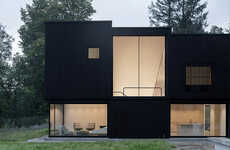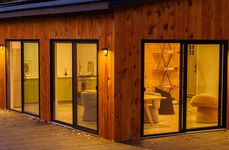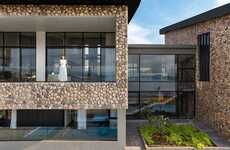
The Lake Lugano House Uses Eco-Materials and Geothermal Energy
Emily Evans — August 29, 2011 — Eco
References: jma.it & letmebeinspired
Some of my favourite abodes -- like the 'Lake Lugano' House -- are the ones I'm naturally drawn to based on their architectural aesthetic, only to be further impressed by their eco-initiatives. This particular pad was designed by the Italian architecture firm JM Architecture with an eye-catching glass exterior, which clearly embraces the home's stunning mountainous surroundings.
The Lake Lugano House has two sections on alternating levels that embrace the natural topography of the land. If you're wondering what exactly makes this house "eco," consider that the Lake Lugano House was built with eco-friendly materials, uses geothermal energy, has special insulation with low-emission and boasts an extensive rooftop garden!
Implications - Consumers continue to expect even higher eco-initiatives from companies who attempt to label themselves as green. While many companies were once able to get away with claiming their were environmentally friendly, all companies should now consider that consumers demand strong eco-efforts in all aspects of so-called "green" companies.
The Lake Lugano House has two sections on alternating levels that embrace the natural topography of the land. If you're wondering what exactly makes this house "eco," consider that the Lake Lugano House was built with eco-friendly materials, uses geothermal energy, has special insulation with low-emission and boasts an extensive rooftop garden!
Implications - Consumers continue to expect even higher eco-initiatives from companies who attempt to label themselves as green. While many companies were once able to get away with claiming their were environmentally friendly, all companies should now consider that consumers demand strong eco-efforts in all aspects of so-called "green" companies.
Trend Themes
1. Eco-friendly Materials - Disruptive innovation opportunity: Developing and marketing new sustainable and non-toxic materials for construction and design.
2. Geothermal Energy - Disruptive innovation opportunity: Creating efficient and affordable geothermal energy systems for residential and commercial buildings.
3. Rooftop Gardens - Disruptive innovation opportunity: Designing modular and accessible rooftop garden systems for urban environments.
Industry Implications
1. Architecture - Disruptive innovation opportunity: Incorporating sustainable design practices and eco-friendly materials into architectural projects.
2. Building Materials - Disruptive innovation opportunity: Developing new eco-friendly building materials and promoting their adoption in the construction industry.
3. Renewable Energy - Disruptive innovation opportunity: Advancing geothermal energy technologies to make them more efficient, cost-effective, and widely accessible.
5.7
Score
Popularity
Activity
Freshness























